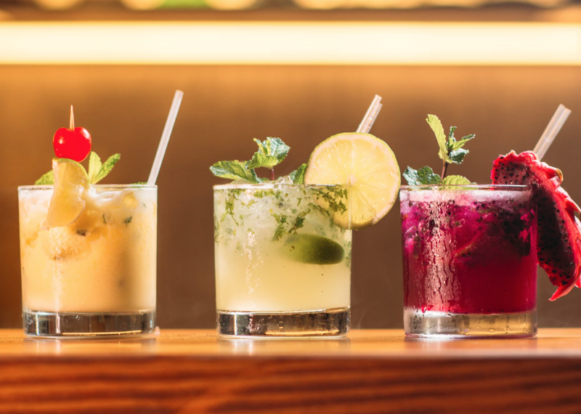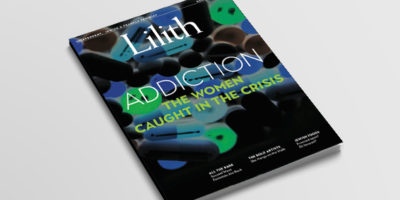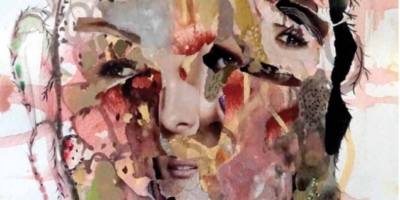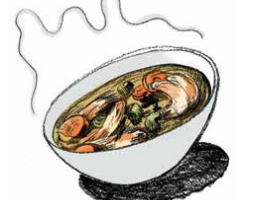Lilith Feature
Addiction: Jewish Women Caught In The Crisis
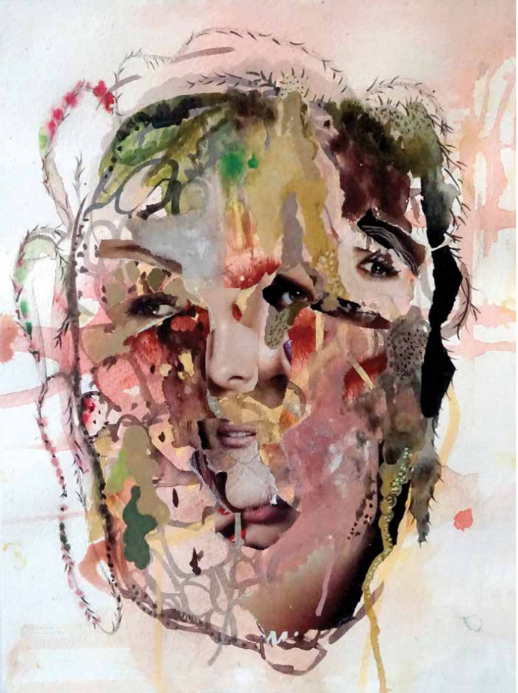
From the spiral ramps that frame New York’s Guggenheim Museum, thousands of small, white sheets of paper—each containing what looked like a prescription for OxyContin—came down like snow. In the lobby several people lay on the floor, staring vacantly at the domed glass ceiling some 90 feet up. Many more stood and chanted, “Sacklers lie, people die.”
The protesters had gathered earlier this year to call attention to the museum’s financial ties to the Sacklers, whose pharmaceutical company makes the powerful painkiller OxyContin. The Sacklers are prominent Jewish philanthropists, and as such their name appears on an arts education center at the Guggenheim, the medical school at Tel Aviv University and a staircase at Berlin’s Jewish Museum. Dozens of U.S. states have sued the Sacklers’ company, Purdue Pharma, claiming deceptive marketing tactics and wrongful drug deaths; earlier this year, the company settled a lawsuit brought by the state of Oklahoma for $270 million. (Under pressure, several cultural institutions, including the Guggenheim and the Jewish Museum, have said that they will no longer accept donations from the Sackler family.)
Opioids—including but not limited to OxyContin and its generics—killed more than 47,000 Americans in 2017. More men than women die from addiction, but the balance is shifting. Earlier this year, a U.S. Centers for Disease Control and Prevention report found that since 1999 opioid overdoses were up a staggering 492% among women ages 30 to 64.
The widespread use of these drugs beyond the depressed rural enclaves where they’ve made headlines, together with the Sacklers’ connection to the crisis, means the opioid epidemic—and addiction more broadly—can no longer be relegated to the status of “someone else’s problem.”
For a long time, “there was a sense that Jews don’t do this,” said Rabbi Ellie Shemtov, a New Jersey rabbi who has written Torah commentaries connected to the 12 steps used in addiction recovery. “Opioids are changing that because more and more people know someone who has been through this,” said Shemtov, whose former husband died of alcoholism in 2010.
Women make up about one-third of the residents at Beit T’Shuvah, the 140-bed drug treatment facility and Jewish congregation in Los Angeles, according to its founder and clinical director, Harriet Rossetto. In recent years, she’s observed an influx of affluent Jewish women who became addicted to prescription opioids following medical procedures. “Because the brain doesn’t differentiate between physical pain and psychic pain, all of the sudden they felt a lot better that they ever felt,” she said. “They kept refilling that prescription and at some point when the doctors stopped giving it, a lot of people got into heroin.”
At the same time their substance abuse is more likely than that of their male counterparts to be shrouded in shame and secrecy. Women often use in the privacy of their homes, and keep their addiction even from those closest to them—lest they be seen as “falling apart.”
“In American Jewish culture, there’s the pressure to succeed, to be the best, to look the best—there’s perfectionism,” Rossetto said. “If you feel that you don’t measure up, and you’re always comparing [yourself ] to other people, I think that’s part of the wound people feel.”
In an effort to dismantle the stigma around addiction, Lilith recently spoke to five American Jewish women in recovery—women driven to abuse prescription drugs or street drugs or alcohol by past traumas, by life transitions, by physical pain, or by casual use that became a physical dependency. Women who sought treatment amid pregnancies or overdoses or realizations that their addictions were leading nowhere good. Their stories are familiar; indeed, they are our stories.
Rachel Schwartz
As her marriage was dissolving, Rachel Schwartz turned to prescription painkillers, and then to a street drug that would dismantle her life as she knew it.
“Once I found meth, nothing else mattered,” Schwartz explained. As she got high, she would cry, feeling “the guilt, the remorse, the pain, and the shame” of her addiction to the dangerous stimulant. But as soon as she came down, those feelings gave way to the familiar question: What do I have left to sell so I can buy more meth?
“Every other concern, including food and water, goes away,” she said. “All the people you love, you can’t see them. All you care about is getting that bag of drugs.”
Schwartz never expected her life path would have led to such a dark and despairing place. She had grown up Jewish in Westchester County, New York, and attended Camp Ramah and Brandeis University. She had moved to Colorado, finished college, gotten married, and worked as a technical recruiter.
And yet, here she was, desperate for her next high. Even if it meant going without meals. Or stealing from friends. Or pawning her mom’s jewelry.
“I’m a good person, but it made me do deplorable things,” she said.
Schwartz was 28 when she started using drugs, as she was divorcing. At first, it was opiates, which she had been prescribed following dental surgery. Realizing she had a problem, she spent some $20,000 to send herself to a fancy rehab facility in Belize, replete with horseback riding and personal training.
Following rehab she moved, temporarily, to Houston, Texas, to be with some of the friends she had met in Belize. It was there that she’d relapse, and try meth for the first time.
“After my divorce, I was on a mission of self destruction—it was purposeful,” she said. “I had shamed my family; I had shamed his family. It was easier to just obliterate myself.”
And she almost did. Once hooked on meth, Schwartz struggled to hold down a job. She once spent a week in jail, locked in a cell for about 23 hours a day after her desperate parents called the cops on her for stealing. When they dropped the charges, Schwartz moved back in with her drug-addicted boyfriend and began using again. A few weeks later, she found out she was pregnant.
This time around, she was determined to get clean, and stay clean. For her son. For herself. She detoxed not at a resort-like rehab, but alongside other drug-addicted pregnant women, some of them homeless and almost all of them enduring painful withdrawal symptoms.
Her son is now a healthy 9-year old.
“He knows mommy is sober,” she said of her son, whom she co-parents alongside her son’s father, also a recovering addict. “He grew up going to AA meetings.”
Schwartz managed to rebuild her career in recruiting. She made financial amends to those from whom she had stolen to buy drugs, and three years ago, she bought a home near Boulder.
“I had always felt like I could never do life on my own as a single woman,” said Schwartz, now 46. “Getting sober and being a single mom was me facing my worst fears.” As hard as that has been, Schwartz said the process “has reminded me how strong I am.”
Emma B.
Casual recreational drug use is common among some subsets of young teens. For Emma B (we are not using her full name because of her age) an early dependency on pills would result in a nearly fatal overdose of the powerful opioid fentanyl. (In 2017, fentanyl and drugs similar to it claimed 28,000 American lives.)
Emma was 14, a high school freshman in Los Angeles, when she started abusing prescription drugs: “Adderall for studying, Xanax for coming down,” she recalled. “Maybe drink on Xanax for going out. If I just wanted to hang out, I’d do opiates. If I wanted to get fucked up, I’d mix it all.”
She could buy them from a dealer or bum them from a friend, noting, “Especially among private schools in West L.A., drugs were easy to access.” At Tulane University in New Orleans, where she enrolled after high school, she continued to use—in part to calm her anxiety, she said.
As a young woman, she was particularly vulnerable. “It’s easy to get taken advantage of ” by male addicts, intent on stealing money and drugs, she said. “Especially at a Greek-heavy school, you have to be on guard,” and that’s more challenging if you’re under the influence.
Plus, it was hard to know what was really in the pills she’d been sold. That was the case several months back, when she took what she thought was OxyContin, a powerful painkiller in its own right, but which had been laced with the far more potent synthetic opioid fentanyl.
By the time her housemate found her unconscious, next to a space heater, Emma’s left thigh had been badly burned. She was rushed to the hospital, where she remained for about a week—detoxing, being treated for the burn, and being closely monitored because she had flatlined before she was revived. “They had to do a lot of tests to make sure my heart was in good condition and my brain was fine, that it wasn’t too deprived of oxygen,” said Emma, now on a medical leave from Tulane.
Her parents, who had flown out to New Orleans to be with her, brought her back to Los Angeles and moved her into Beit T’Shuvah (Hebrew for “House of Repentance”), the L.A. addiction treatment facility and Jewish congregation. When she spoke with Lilith in the spring, she had been living at Beit T’Shuvah for five months, and expected to remain there for at least two more months. The treatment program there incorporates Jewish spiritual practices, which Emma said “is a cornerstone of many people’s recovery,” though not her own.
Emma, who considers herself culturally Jewish but is not observant, said that the 12-step work she’s done through Beit T’Shuvah has encouraged her to connect to something greater than herself (putting faith in a higher power is Step Two). Key to staying clean when she’s back at school—she is an English major and an aspiring magazine writer—will be attending 12-step program meetings and “finding something more tangible to believe in because I don’t think I’ve fully defined what my higher power is yet.”
Erin Khar
For Erin Khar, of New York City, developing a spiritual practice, and ultimately converting to Judaism, has been pivotal to her recovery from heroin addiction.
In her forthcoming memoir, Strung Out (Park Row Books, 2020), she writes about the night when, inside a Beverly Hills mansion, she shot up for the first time, and then lost her virginity. Khar had just turned 13.
Khar then struggled with addiction on and off for the better part of a decade, and almost no one in her life knew. Nor did they have reason to suspect that she was using. She was a straight-A student at a suburban Los Angeles prep school, a horseback rider and a cheerleader. When, at age 23, Khar was caught with drugs—by her then-fiancé—many who loved her, especially her parents, “were in such denial that this could really be my problem.” It seemed so unlikely.
Meanwhile, Khar was eager to name her problem. “I wanted to say, ‘This is what’s wrong with me. I’m an addict’,” she said. But there was more to it. She had been sexually abused as a child, and had struggled with suicidal thoughts since she was 8. Heroin, she said, was symptomatic of early trauma, of mental illness and of a primal fear “that if anyone knew about this, they wouldn’t love me.”
Khar tried to stop many times over the years, but always relapsed—until, that is, she found out she was pregnant, got clean, and has stayed clean ever since. Her son is now 15, and an accomplished ballet dancer.
“When my son was born, it felt like a switch flipped,” said Khar, now an editor and advice columnist for the website Ravishly. “I loved this baby more than I hated myself, and thatlaid the foundation for living without drugs, and regulating my emotions, for showing up in my life.”
She went to therapy and went on psychiatric medication that helped stabilize her mood. She also developed a spiritual practice, involving meditation, Kundalini yoga, and ultimately Judaism—her now-husband’s faith, to which she converted in 2014. (She is the daughter of a Swedish-American mother and an Iranian-born father, and grew up in a secular home where some Christian holidays were celebrated.)
Her journey “came full circle with Judaism because it provided a way to connect with my spirituality, with community, with tradition, with my family unit,” said Khar, 45, who now also has a 2-year-old son. Being part of a spiritual community, she said, may help ease the loneliness, isolation and lack of self-worth that drive so many people turn to drugs in the first place. For Khar, her adopted faith helps root her, and the Jewish imperative to repair the world “is very important for recovery because we build self-esteem when we are of service to others.”
Chani Lisbon
The ready availability of kiddush wine provided early exposure to alcohol. Right away, Chani Lisbon liked how it made her feel; only years on did she understand she had a problem.
Lisbon was 15 when she would often find herself around her married sister’s Shabbat table—drinking alcohol with boys from a local yeshiva.
Lisbon, now 37, grew up in Los Angeles, where her father was an emissary with Chabad-Lubavitch, the Hasidic movement known for its Jewish outreach efforts. She is one of 11 siblings (including half-siblings).
After high school she attended a religious seminary in Brooklyn, and later went to work in Manhattan’s famed diamond district. It was then that she realized that her relationship with alcohol looked different from that of her peers. Drinking wasn’t recreational, said Lisbon: “I needed it. I couldn’t go to the movies without alcohol. I couldn’t go to the grocery store without a buzz.” She spent her work day counting the number of hours left till she could leave work and have a drink. Grey Goose vodka, she said, “became a friend.”
“I don’t know if I was born an alcoholic,” she said, “and I don’t spend time wondering about it because it doesn’t really matter. I just know that I am one.”
Lisbon is a Brooklyn-based stand-up comedian now, though she rarely addresses her alcoholism in her act. But she does get personal, talking about her sexuality—she is single, has dated men and women, and identifies as queer—and her struggles with anxiety and an autoimmune condition that makes her hair fall out. “I was diagnosed with TMJ,” she’ll tell the crowd. “Too Much Jew.”
In all seriousness, trauma and pain were at the root of her addiction, she said. When at 25 she went, at a friend’s invitation, to a local support group for those who struggle with drinking, she could not imagine going a day without alcohol, “but by the grace of a power I don’t even understand, I was able to get sober,” Lisbon has said onstage.
It’s one day at a time—sometimes, an hour at a time—but she has been sober for more than 11 years.
Jen Simon
The trials of new motherhood, compounded by postpartum depression and anxiety, led Jen Simon to try one pill, prescribed to her for back pain and severe menstrual cramps.
At first, Percocet provided Simon, a stay-at-home mother in New Jersey, welcome relief of her physical and psychic pain. At the time, her baby was waking up every 45 minutes or so, and this went on for months. The sleep deprivation took its toll. Percocet, though, made everything feel more tolerable. It didn’t make her feel “high,” but rather “just a more relaxed, better version of myself.”
That was in the beginning, before one pill a day turned into six pills a day, turned into 10 pills a day, from six different doctors writing prescriptions. “If any of them had looked at my medical history, they would have seen drug-seeking behavior.” But none of them did, she said.
Two years in, Simon finally told her husband and her mother that she was addicted to painkillers. Her mom flew in to help as she detoxed on the couch, a process Simon described as “kind of like the flu, but more terrible.”
As soon as her mom left town, Simon relapsed, telling no one. She managed to quit when she became pregnant with her second son, but as soon as she was offered medication to treat pain following his Caesarean birth, “I was like, ‘Hooray, my body is mine again,” and Simon became hooked once more. She continued to use in secret for the better part of three years after her initial detox at home.
The end came into sight only when she realized that the medications she had been prescribed, and those she was stealing from other people’s medicine cabinets, were no longer providing relief. She needed more pills, stronger pills. She knew she had a choice to make: get help or get a dealer. If she chose the latter, if she went from Percocet and morphine to OxyContin, “how far away could heroin be?” she wondered, noting that heroin had always been a red line for her.
That’s when she finally admitted to her husband and her parents that she was still struggling. Detox, rehab, individual therapy, group therapy, opioid blockers to curb cravings, antidepressants, and participation in an intensive outpatient program followed. So, too, did an essay she wrote in the Washington Post, titled, “I’m a stay-at-home mom. I’m an addict.”
A contributor to the Jewish parenting site Kveller, Simon recalled the supportive feedback she received when she wrote previously about her struggles with postpartum depression. Still, she feared that opening up about addiction was something that would drive people away.
“I thought I was going to lose friends, left and right, that people would abandon me,” Simon, 42, said. “I didn’t know if they’d let their kids play with my kids anymore.”
Instead, her circle has grown—as strangers, some of whom she now considers friends, have come forward. She now runs a secret Facebook group for some 90 moms struggling with addiction. This is me, women in the group tell her. I felt so alone until I saw this.
Gabrielle Birkner is a Los Angeles-based writer and editor. She is the co-founder of Modern Loss, and she is the co-author of Modern Loss: Candid Conversation About Grief. Beginners Welcome (Harper Wave, 2018).
Art: Deborah Wasserman, “Plurabelle,” www.deborahwasserman.com


